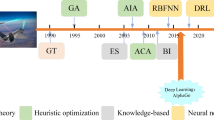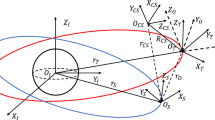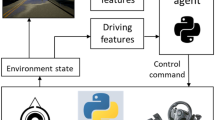Abstract
For the attitude control of hypersonic vehicles, a control scheme based on linear active disturbance rejection (LADRC) and modified deep deterministic policy gradient (MDDPG) is proposed. Firstly, LADRC is used to deal with uncertainty and nonlinear problems in the attitude control process. For the tedious manual parameter tuning process, MDDPG is used to optimize the control gains and bandwidth of LADRC. Secondly, a modified reward function and an early stop criterion are introduced in the MDDPG algorithm to improve the optimization performance. Then, another MDDPG is used as an auxiliary control, which is combined with LADRC for attitude control to improve the robustness and accuracy of the control. The proposed method considers the robustness and rapidity of the control. Finally, the effectiveness of the proposed method is proved by simulation. Compared with traditional LADRC, LADRC based on the Q-learning algorithm, LADRC based on the traditional DDPG algorithm, and LADRC based on MDDPG algorithm, the proposed method has a better control effect and can avoid a lot of manual parameter tuning.












Similar content being viewed by others
Data availability
No datasets were generated or analyzed during the current study.
References
Urzay J (2018) Supersonic combustion in air-breathing propulsion systems for hypersonic flight. Ann Rev Fluid Mech 50:593–627
Wang Y, Yang X, Yan H (2019) Reliable fuzzy tracking control of near-space hypersonic vehicle using aperiodic measurement information. IEEE Transact Ind Electron 66(12):9439–9447
Tang S, Hu C (2017) Design, preparation and properties of carbon fiber reinforced ultra-high temperature ceramic composites for aerospace applications: a review. J Mater Sci Technol 33(2):117–130
Zhang H, Wang H, Li N, Yu Y, Su Z, Liu Y (2020) Time-optimal memetic whale optimization algorithm for hypersonic vehicle reentry trajectory optimization with no-fly zones. Neural Comput Appl 32:2735–2749
Ding Y, Yue X, Chen G, Si J (2022) Review of control and guidance technology on hypersonic vehicle. Chin J Aeronaut 35(7):1–18
Xu B, Wang X, Shi Z (2019) Robust adaptive neural control of nonminimum phase hypersonic vehicle model. IEEE Transact Syst Man Cybern Syst 51(2):1107–1115
Yuan Y, Wang Z, Guo L, Liu H (2018) Barrier lyapunov functions-based adaptive fault tolerant control for flexible hypersonic flight vehicles with full state constraints. IEEE Transact Syst Man Cybern Syst 50(9):3391–3400
Xu B, Shi Z (2015) An overview on flight dynamics and control approaches for hypersonic vehicles. Sci China Inf Sci 58(7):1–19
Qiao H, Meng H, Wang M, Ke W, Sun J (2019) Adaptive control for hypersonic vehicle with input saturation and state constraints. Aerosp Sci Technol 84:107–119
Wang Y, Chao T, Wang S, Yang M (2019) Byrnes-isidori-based dynamic sliding-mode control for nonminimum phase hypersonic vehicles. Aerosp Sci Technol 95:105478
Zuo R, Li Y, Lv M, Liu Z (2021) Realization of trajectory precise tracking for hypersonic flight vehicles with prescribed performances. Aerosp Sci Technol 111:106554
Wu G, Meng X, Wang F (2018) Improved nonlinear dynamic inversion control for a flexible air-breathing hypersonic vehicle. Aerosp Sci Technol 78:734–743
Kürkçü B, Kasnakoğlu C, Efe MÖ (2018) Disturbance/uncertainty estimator based integral sliding-mode control. IEEE Transact Autom Control 63(11):3940–3947
Zhang S, Wang Q, Yang G, Zhang M (2019) Anti-disturbance backstepping control for air-breathing hypersonic vehicles based on extended state observer. ISA Transact 92:84–93
Feng J, Yin B (2021) Improved generalized proportional integral observer based control for systems with multi-uncertainties. ISA Transact 111:96–107
Wu Z, Ni J, Qian W, Bu X, Liu B (2021) Composite prescribed performance control of small unmanned aerial vehicles using modified nonlinear disturbance observer. ISA Transact 116:30–45
Piao M, Yang Z, Sun M, Huang J, Chen Z (2019) A practical attitude control scheme for hypersonic vehicle based on disturbance observer. Proc Inst Mech Eng Part G J Aerosp Eng 233(12):4523–4540
Han J (2009) From PID to active disturbance rejection control. IEEE Transact Ind Electron 56(3):900–906
Huang Z, Chen Z, Zheng Y, Sun M, Sun Q (2021) Optimal design of load frequency active disturbance rejection control via double-chains quantum genetic algorithm. Neural Comput Appl 33:3325–3345
Gao Z (2003) Scaling and bandwidth-parameterization based controller tuning. In: ACC, pp. 4989–4996
Rugh WJ, Shamma JS (2000) Research on gain scheduling. Automatica 36(10):1401–1425
Piao M, Yang Z, Sun M, Huang J, Wang Z, Chen Z (2018) Synthesis of attitude control for statically unstable hypersonic vehicle with low-frequency aero-servo-elastic effect. Aerosp Sci Technol 80:67–77
Wang Y, Han Z (2021) Ant colony optimization for traveling salesman problem based on parameters optimization. Appl Soft Comput 107:107439
Yang L, Chen H (2019) Fault diagnosis of gearbox based on RBF-PF and particle swarm optimization wavelet neural network. Neural Comput Appl 31:4463–4478
Rana N, Latiff MSA, Abdulhamid SM, Chiroma H (2020) Whale optimization algorithm: a systematic review of contemporary applications, modifications and developments. Neural Comput Appl 32:16245–16277
Yin Z, Du C, Liu J, Sun X, Zhong Y (2017) Research on autodisturbance-rejection control of induction motors based on an ant colony optimization algorithm. IEEE Transact Ind Electron 65(4):3077–3094
Cai Z, Lou J, Zhao J, Wu K, Liu N, Wang YX (2019) Quadrotor trajectory tracking and obstacle avoidance by chaotic grey wolf optimization-based active disturbance rejection control. Mech Syst Signal Process 128:636–654
Faraji B, Gheisarnejad M, Yalsavar M, Khooban M (2020) An adaptive ADRC control for parkinson’s patients using machine learning. IEEE Sens J 21(6):8670–8678
Wang Y, Fang S, Hu J (2022) Active disturbance rejection control based on deep reinforcement learning of PMSM for more electric aircraft. IEEE Transact Power Electron 38(1):406–416
Schmidhuber J (2015) Deep learning in neural networks: an overview. Neural Netw 61:85–117
Silver D, Schrittwieser J, Simonyan K, Antonoglou I, Huang A, Guez A, Hubert T, Baker L, Lai M, Bolton A et al (2017) Mastering the game of go without human knowledge. Nature 550(7676):354–359
Luong N, Hoang D, Gong S, Niyato D, Wang P, Liang Y, Kim D (2019) Applications of deep reinforcement learning in communications and networking: a survey. IEEE Commun Surv Tutor 21(4):3133–3174
Raafat S, Mohammad EH, Belal AZ, Tarek AM (2023) Optimal fractional-order PID controller based on fractional-order actor-critic algorithm. Neural Comput Appl 35(3):2347–2380
He S, Zhang M, Fang H, Liu F, Luan X, Ding Z (2020) Reinforcement learning and adaptive optimization of a class of Markov jump systems with completely unknown dynamic information. Neural Comput Appl 32:14311–14320
Li X, Zhang Z, Ji Y, Liu J, Gao Q (2023) Q-learning-based practical disturbance compensation control for hypersonic flight vehicle. Proc Inst Mech Eng Part G J Aerosp Eng 237(8):1916–1929
Zheng Y, Sun Q, Chen Z, Sun M, Tao J, Sun H (2021) Deep Q-network based real-time active disturbance rejection controller parameter tuning for multi-area interconnected power systems. Neurocomputing 460:360–373
Zhao K, Song J, Hu Y, Xu X, Liu Y (2022) Deep deterministic policy gradient-based active disturbance rejection controller for quad-rotor UAVs. Mathematics 10(15):2686
Chen G, Chen Z, Wang L, Zhang W (2023) Deep deterministic policy gradient and active disturbance rejection controller based coordinated control for gearshift manipulator of driving robot. Eng Appl Artif Intell 117:105586
Zheng Y, Tao J, Hartikainen J, Duan F, Sun H, Sun M, Sun Q, Zeng X, Chen Z, Xie G (2023) DDPG based LADRC trajectory tracking control for underactuated unmanned ship under environmental disturbances. Ocean Eng 271:113667
Wang Y, Sun J, He H, Sun C (2019) Deterministic policy gradient with integral compensator for robust quadrotor control. IEEE Transact Syst Man Cybern Syst 50(10):3713–3725
Marrison CI, Stengel RF (1998) Design of robust control systems for a hypersonic aircraft. J Guid Control Dyn 21(1):58–63
Wang Q, Stengel RF (2000) Robust nonlinear control of a hypersonic aircraft. J Guid Control Dyn 23(4):577–585
Parker JT, Serrani A, Yurkovich S, Bolender MA, Doman DB (2007) Control-oriented modeling of an air-breathing hypersonic vehicle. J Guid Control Dyn 30(3):856–869
Shuprajhaa T, Sujit SK, Srinivasan K (2022) Reinforcement learning based adaptive PID controller design for control of linear/nonlinear unstable processes. Appl Soft Comput 128:109450
Wang Y, Zhang X, Zhou R, Tang S, Zhou H, Ding W (2022) Research on UCAV maneuvering decision method based on heuristic reinforcement learning. Comput Intell Neurosci 2022:1477078
Funding
This work was supported by the National Natural Science Foundation of China under Grants 62203331.
Author information
Authors and Affiliations
Corresponding author
Ethics declarations
Conflict of interest
The authors declare that they have no conflict of interest.
Additional information
Publisher's Note
Springer Nature remains neutral with regard to jurisdictional claims in published maps and institutional affiliations.
Appendix A
Appendix A
The expression for \({c_x}\) is as follows
where
The expression for \({c_y}\) is as follows
where
The expression of \({m_z}\) is as follows
where
Rights and permissions
Springer Nature or its licensor (e.g. a society or other partner) holds exclusive rights to this article under a publishing agreement with the author(s) or other rightsholder(s); author self-archiving of the accepted manuscript version of this article is solely governed by the terms of such publishing agreement and applicable law.
About this article
Cite this article
Xu, L., Yuehui, J., Yu, S. et al. Modified deep deterministic policy gradient based on active disturbance rejection control for hypersonic vehicles. Neural Comput & Applic 36, 4071–4081 (2024). https://doi.org/10.1007/s00521-023-09302-5
Received:
Accepted:
Published:
Issue Date:
DOI: https://doi.org/10.1007/s00521-023-09302-5




